
December 2011
In This Edition
- Christmas Bird Count
by Andrew Donovan-Shead - Downy & Hairy Woodpeckers
by Nicholas Del Grosso - Bison Roundup
by Bob Hamilton, Director of the Tallgrass Prairie Preserve - Learn the Butterflies
by George Pierson - Workin’ the Roundup
by Steve Forsythe - Tundra Swans, Cygnus columbianus
by Nicholas Del Grosso - Docent Coverage of Season Days
by Andrew Donovan-Shead - Other Places to Visit
- Tallgrass Prairie Preserve Visitor’s Center Latitude & Longitude
- Kiosk Maintenance
- Back Issues
- Selected Topics Index
- Newsletter Publication
Christmas Bird Count
—Andrew Donovan-Shead
Don Wolfe, Senior Biologist at the Sutton Avian Research Center, has announced the date of the Christmas Bird Count for Monday, 2 January 2012 at the Tallgrass Prairie Preserve. Anyone with an interest in birds is welcome to participate. If you are inexperienced then you will be placed with an experienced birder. Don can be reached by email at dwolfe@ou.edu or by telephone at 918-336-7778.
Downy & Hairy Woodpeckers
—Nicholas Del Grosso
Downy Woodpecker (Picoides pubescens):
I have often spent time walking the Tallgrass Prairie Preserve Hiking Trails watching for woodpeckers and I am never disappointed. The one I see most often is the Downy Woodpecker. This bird is the smaller of the two look-alike woodpeckers, in fact it is the smallest North American Woodpecker. You can find this bird almost anywhere there are trees near rivers, parks and backyards. It readily comes to feeders, suet cages and even nectar feeders. While you can never predict where you will find this bird on a tree, it is most often found working the smaller branches, rather than the trunk and main branches, looking for insects and insect larvae.
Winter is a great time to look for woodpeckers because the tree leaves do not interfere with your line of sight. The Christmas Bird Count always finds a large number of Downy’s. Last year 23 were spotted, while the twelve-year running average for the Christmas Bird Count has been 29.
The Downy’s average size is 6-7 inches long with about an 11-inch wingspan. It is not a flashy bird, sporting only black and white with the males having a red patch on the back of their head.
There are two key features to remember when distinguishing a Downy from a Hairy Woodpecker: (1) Size—the Downy is smaller; (2) Length of bill—the Downy’s bill is less than half the length of the head.
Sometimes Downy’s can be seen associating in mixed species flocks of Chickadees and Nuthatches. There are advantages to this type of flocking for the Downy which include more eyes looking for predators and better luck finding food. I have noticed at my feeders that when Chickadees, Titmice and Nuthatches are present you will often see a Downy or two. If a male Downy is present he will tend to dominate the feeder he is using.
The Downy eats what the larger woodpeckers cannot reach. In addition to working tree branches you will sometimes see them foraging for insects on or in the stems of weeds. During the winter sometimes you will see them hammering on goldenrod galls to get at the fly larvae inside. The Downy’s diet makes him a gardener’s best friend. It eats pest insects during the summer including corn earworm, tent caterpillars, bark beetles and apple borers. About 25-percent of their diet comes from plants; they are particularly fond of berries, acorns and grains. I have noticed that they prefer black oil sunflower seeds. They will often take a seed from the feeder flying back to perch on a branch to enjoy their prize. They also like to work the seed heads of my giant sunflowers in the garden and they are very adept at extracting the seed from the head.
The Downy will breed from March through June, often double brooding. Both the male and female will excavate the nest hole. This will often be in a dead tree or in dead parts of a live tree. The excavation can take 1 to 3 weeks. The hole is often 1-1½ inches across and 6 to 12 inches deep. The hole is lined only with woodchips.
Typically 4 to 5 pure white eggs are laid. These eggs will be incubated by both sexes for 12 days. Interestingly, the male tends to incubate the eggs at night. The hatchlings are active and can climb to the cavity entrance at 12 days. They leave the nest between 20 to 22 days of age but stay with the parents for another three weeks.
Hairy Woodpecker (Picoides villosus):
The Hairy Woodpecker is the larger of this duo, but not by much. They tend to average about 9¾ inches in length and have a 15-inch wing span.
If you don’t have a point of comparison at a distance identification can be confusing, size is sometimes distorted, A sure way to make that positive identification is to focus on the woodpecker’s beak, If the beak is as long as the head you are looking at a Hairy Woodpecker. Colors on this bird are similar to the Downy, the only exception being that the Downy has spots of black on its white tail feathers. The Hairy has no spots.
Although the Hairy and Downy look alike they are not closely related.
They are an example of convergent evolution. Darwin explains convergent
evolution in his Origin of Species by stating …as animals
belonging to two most distinct lines may have become adapted to similar
conditions, and thus have assumed a close external resemblance; but such
resemblances will not reveal—will rather tend to conceal—their
blood-relationship.
In any event due to the size difference between
the Hairy and Downy ecological competition between the two species is
slight. For instance when you see a Hairy they will usually be seen
foraging on the trunk or main branches of the tree. You will not see a
Hairy foraging on weed stems; size becomes a limiting factor.
Hairy Woodpeckers are opportunistic feeders and will be attracted when they hear the heavy sounds of a Pileated Woodpecker feeding. As the Pileated moves on the Hairy will fly in to investigate, often taking insects the Pileated has missed. The Hairy will also drink sap leaking from wells in the bark made by sapsuckers.
Hairy Woodpeckers are found in the same types of environments as the Downy; however, they exploit different segments of that environment.
About 75-percent of the Hairy’s diet is made up of insects. They are particularly fond of wood-boring beetles, bark beetles, ants and moth pupae in cocoons. The Hairy, to a lesser extent, will also eat a wide range of insects, including bees, wasps, caterpillars, spiders, millipedes and sometimes cockroaches, crickets and grasshoppers. Because of their fondness for bark beetles they aid in maintaining the health of our forests. When there is an infestation of bark beetles, Hairy Woodpeckers often appear in mass to eat the larvae. They will also appear in recently burned forests feeding on wood-boring species. They are beneficial to farmers in that they help control codling moths in orchards.
This bird is less common at the Tallgass Prairie Preserve than the Downy. Christmas Bird Counts over the past twelve years have averaged 4 a year. Last year only 3 were spotted on the Count.
Hairy Woodpeckers will start excavating a nest cavity in the dead stub of a living tree less than 2 weeks before egg-laying. The cavity will be 2 inches tall and 1½ inches wide and 8 to 12 inches deep. The Hairy is larger than the Downy, so consequently the cavity is also a little larger.
Reproduction rates are lower for the Hairy. They single brood 4 to 6 eggs between April and June. It takes 11 to 15 days to hatch and 29 to 30 days to fledge after hatching. After leaving the nest they will stay with the adults for another two weeks.
Conclusion:
Both the Hairy and Downy drum. Drumming is a form of communication—like a song bird’s song—which is why houses and metal gutters attract woodpeckers. These items make a louder noise than trees. Drumming is used to establish and defend a territory, as part of courtship, to solicit mating, to summon a mate or in response to an intruder. They use drumming the way we use a cell or landline phone. It’s just a better way of communicating than song.
Both of these birds can be found at the Tallgrass Prairie. They are listed as species of least concern and their populations are stable. They both are interesting to watch so the next time you hike the kiosk trails at the Prairie keep an eye out for this dynamic duo.
[Click on the sub-heads above to hear how much wood a woodpecker pecks when a woodpecker would peck wood. Editor.]
Bison Roundup
—Bob Hamilton, Director of the Tallgrass Prairie Preserve
Here is some additional roundup information that may help clarify things.
The culled animals are actually sold by sealed bid, with the bid deadline
several weeks before the processing of the herd. Animals to be sold are
held in the corral pens after they come through the squeeze chute. Keeper
animals are released from the squeeze chute and run about 300 yards north
up the central alley to the 50-acre North Trap. Calves are also put in
this same relatively small trap to let them have a good chance of finding
mom
after they have been worked. About 24 hours after all the herd has
been worked, they are let out of the North Trap into the 1310-acre Mary L
pasture. A few days later the herd is then let back into their 24,000-acre
year-round unit.
Learn the Butterflies
—George Pierson
Some of the most common things you will see on a walk at the prairie are butterflies. To date there have been ninety-three species of butterflies observed at the Tallgrass Prairie Preserve. Being able to identify them adds a new dimension to your time at the prairie. Some types of butterflies, like swallowtails and fritillaries, can be relatively easy to identify. Others, like the skippers, can be challenging at best, but all are beautiful.

There are many field guides and online resources available for butterfly identification. Two of the more popular guides are:
- Kaufman Field Guide to Butterflies of North America by Jim P. Brock and Kenn Kaufman
- Butterflies of Oklahoma, Kansas, and North Texas by John M. Dole, Walter B. Gerard and John M. Nelson.
Good on-line resources are:
The Tallgrass Prairie Preserve Visitor’s Center sells an interactive CD, Butterflies of the Carolinas and Virginias, that includes all but one of the butterflies currently found at the Tallgrass Prairie Preserve. There is also a Yahoo group, Okleps, for anyone interested in the latest news about butterflies in Oklahoma. In addition to a field guide, a pair of binoculars that can focus on subjects only a few feet away, and a camera with a macro lens will help with identification.
Probably the best way to learn is to participate in the butterfly counts held across the state. Beginners are always welcome and you will be with people who can help you to recognize the many species. Dates and times for these are posted on the Okleps yahoo group. Counts are held every year at some of The Nature Conservancy’s Oklahoma preserves. Current lists of species observed at the preserves can be found on the Tallgrass Docent Program web-site. In Tulsa, another excellent resource is the Mary K. Oxley Nature Center, which has monthly butterfly walks during the butterfly season.
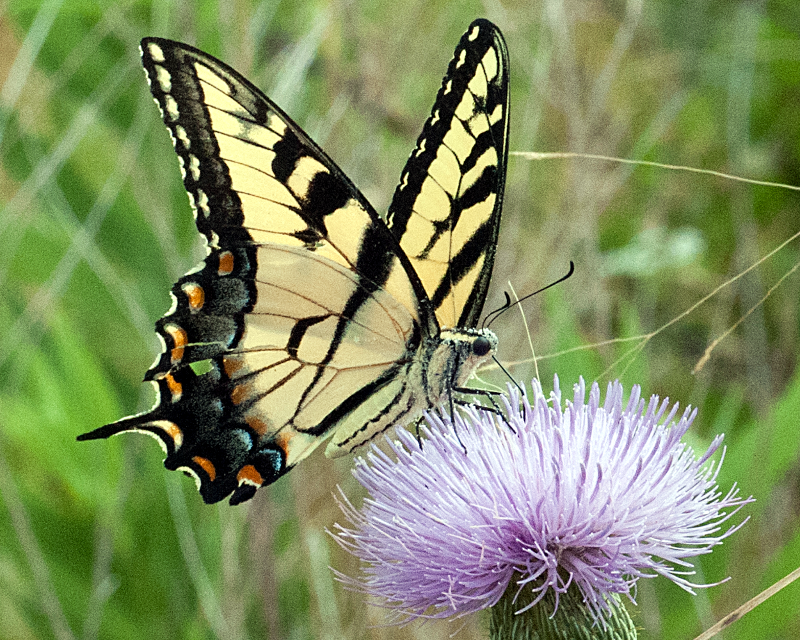
Workin’ the Roundup
—Steve Forsythe
I just viewed Andrew’s nice video about the 2011 Bison Roundup at
the Preserve. I can proudly say that I was there each and every day,
working to move the animals through the gates and pulling tail hairs from
the calves. Thus in one way or another, I handled
each of the 2,800
critters (but who is counting?). I have done this for several years and
continue to consider it an honor to be allowed to take part in that huge
job. I think I can share my impressions and experiences in two categories.
People:
Some might think it is all about the bison, but that’s not so. When I work the Roundup I get to reacquaint myself with the Tallgrass Prairie Preserve staff I seldom see any other time. This includes:
- Kay keeping track of all of the bison and workers too;
- Bob making constant decisions about the animals;
- Perry running the gate;
- Joe Bob, Kevin, and Tony keeping the animals fed into the chute;
- Dwight metering the animals from the last gate into the chute;
- Ann and Tawnda do something—ah yes, they provide some great grub to keep up our energy levels and maybe the ole waistlines to!
Then there are the other helpers who come from other Nature Conservancy locations to help out, like Jeremy, Jeremiah, Jay, Jona, plus neighbors and friends who come from near and not so near to help. This year we had four fellas from Illinois who were great help while learning about starting a bison herd at The Nature Conservancy’s Nachusa Grasslands Preserve in a few years. They bunked with me at the Stucco house and we had some grand discussions over their beer.
The thing that always just impresses the heck out of me is the way the whole thing works, despite:
- The vagaries of OK weather—over the seven days we had dusty seventy degree days when I wore short sleeved shirts; cold days when I had on four layers and could have stood more; rain; and the wind—the ever present wind, from at least four directions.
- Equipment malfunctions whether it was computers or gates or something else.
- Waiting on the vet.
- Other this’s and that’s
What overcomes all these factors are the highly motivated people. I often saw people running or jumping or climbing with some urgency to get something fixed or corrected or changed! No lollygaggin’ I will tell you! Just a bunch of people working hard at some very good work!
Bison:
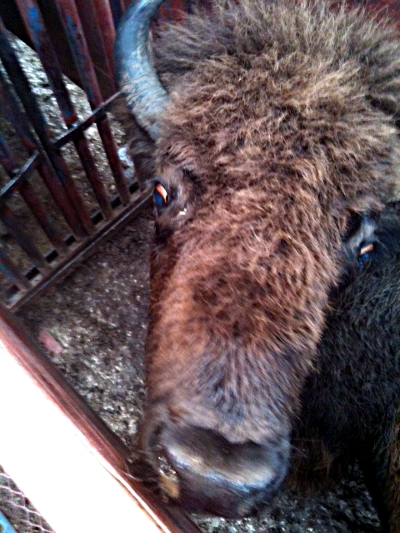
We know that bison don’t care to be messed with. They really, really
don’t like being crowded up with their fellow bison and pushed into
narrow metal aisles and chutes. They are quite powerful, even the small
ones, and can do some fairly surprising acrobatics. So, just when one
thinks all are tame and controlled, a bison will remind you that you must
pay attention at all times. When I work the gates from the catwalk, I know
it is not wise to spend too much time looking down on an excited yearling
or bull or even some cows. They can rear up with their head and horns
above the top of the six foot tall chute. Not something you want to have
contact with, believe me! Others, especially older cows will placidly walk
from gate to gate. While in my gate, at least, some of the cows would turn
their head up towards me and look with those big brown eyes as if to say:
Why are you making me go though this again?
Pulling tail hair follicles from the 2011 calves is its own experience for many reasons. The hair samples are noted for each animal and sent away to be analyzed for the presence of cattle genes. The art of tail hair pulling requires some fairly fancy maneuvering. First, one has to grab the tail, which can be quite elusive as the excited calf is being squeezed in the chute. Second, the sooner one secures the tail, the less the chance of the tail becoming, shall we just say soiled, by the squeezed animal. Third, the hair is extracted by means of pliers and some of the hair is not easy to pull. Fourth, the calf is also about to get branded and the branding iron is something to avoid. Finally, if one does not get sufficient hair follicles, more hair is needed, which slows up the animal movement process. This year hair pulling process was repeated for about 750 calves—research sampling quickly became work.
Conclusion:
Well, there it is. There are more stories I could tell, but I mostly just wanted to offer my perspective of the experience.
Tundra Swans, Cygnus columbianus
—Nicholas Del Grosso
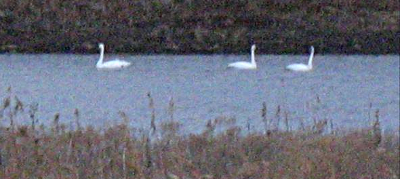
On the second day of Christmas my true love gave to me two swans a swimming! Well it wasn’t the second day of Christmas it was December 3 and it was cold and wet at the Tallgrass Prairie. I worked my docent shift and I was the only visitor, so consequently I was my best customer that day. As the saying goes even the worst day at the prairie is better than the best day at the office and I was about to prove this maxim. At 4 o’clock I decided to see what birds the cold front had pushed down so I headed north towards the bison pens checking out ponds, to my surprise most were low or dry from this past summers drought. I made a wide circle west and between the Foraker turnoff and the east road of the bison loop something white caught my eye on a pond holding 70 ducks. I had seen some Canvasbacks early in the morning on this same pond, so I stopped to investigate.
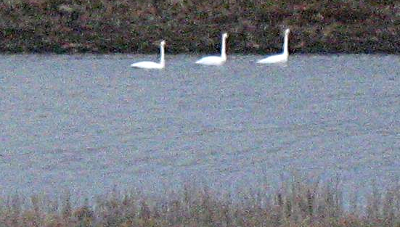
The white turned out to be three Swans swimming, I initially hoped they might be Trumpeter Swans but I wanted to rule out Tundra swans so I set up my scope and zeroed in on the heads and picked up a yellow tear on one below the eye on the bill, well there was no question now these were Tundra Swans migrating through to their wintering grounds, I tried to get closer for some better camera shots but they started to get nervous.
You can see them craning their necks as they spotted me inching forward. I can understand why they appear nervous some 400-6000 Tundra’s are shot every year as they migrate south. The inevitable happened next!
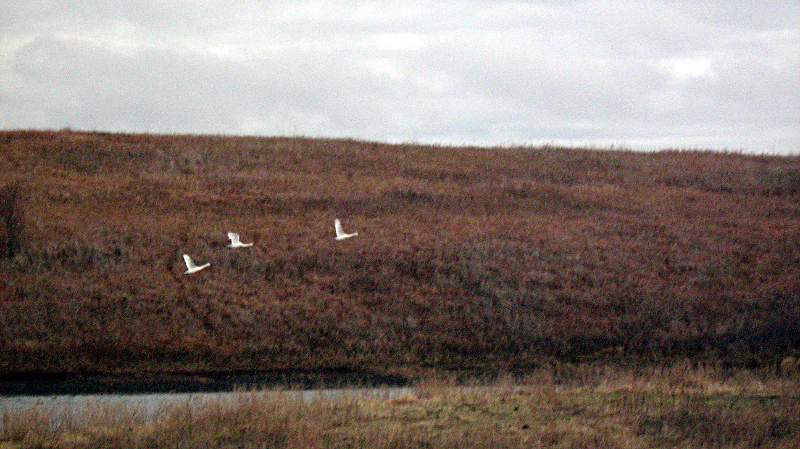
They flew off to find a safer spot for the night. I can’t explain what a rush it was to see Swans on the prairie. We have spooked them infrequently on the Christmas Bird count but it just goes to show you that you never know what you will see driving too or from your docent shift. The Prairie is an ever changing mosaic. What starts out as cold and rainy can end in shadows and sunshine.
Click this link to hear the voice of the Tundra Swan.
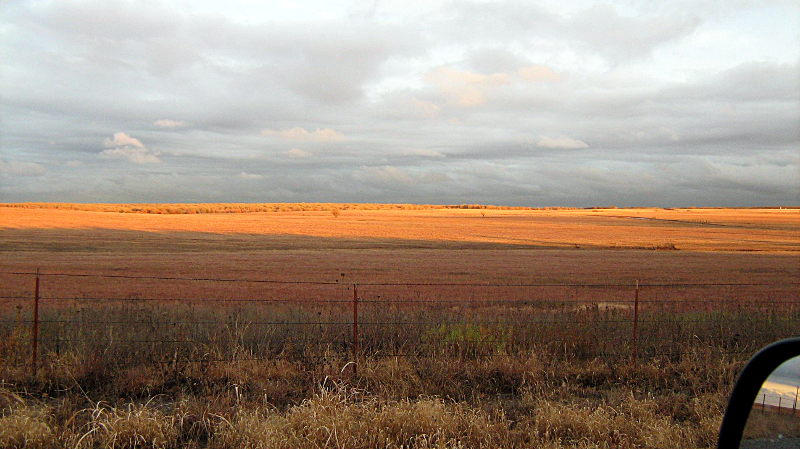
Docent Coverage Of Season Days
—Andrew Donovan-Shead
Six consecutive months with 100-percent coverage of the Visitor’s Center must be a record. It looks like we will have only six days closed by the end of the season.
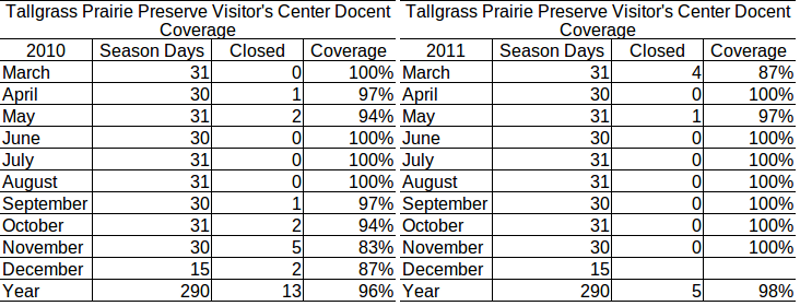
Other Places to Visit
Here we provide some links to other places worth visiting.
- http://crosstimber.wordpress.com/. Observations from Oklahoma’s Osage Hills State Park by Ranger Kyle Thoreson. This site has excellent photography by Ranger Thoreson. The Park is downstream Sand Creek from the Visitor’s Center.
- http://keep.konza.ksu.edu/docents/. Konza Prairie Docent Program discovered by John Fisher.
Tallgrass Prairie Preserve Visitor’s Center Latitude & Longitude
Here is the latitude and longitude of the Visitor’s Center that you can give to visitors for entry into their GPS navigation device.
- N36° 50.774′
- W096° 25.381′
Kiosk Maintenance
The manufacturer’s instructions for cleaning the touch-screen recommend use of a soft dry cloth only. This proved inadequate for smeared fingerprints. Soft-paper kitchen towels work well, slightly damp with a small drop of soft handsoap. Application of a dry kichen towel removes any residual moisture.
Over time, a matter of several weeks continuous operation, I have noticed that calibration of the touch-screen drifts away from the initial set-point. If you notice that the cursor isn’t under your finger when you touch the screen then restart the kiosk by unplugging it from the wall, waiting a few moments and then re-inserting the power plug. It will restart and recalibrate.
This link points to the complete Kiosk Maintenance Manual.
Back Issues
Some printed back issues of the Docent Newsletter, to February 2009, can be found in the two green and one blue-black zip-binders, stored in the Perspex rack by the file cabinet in the office of the Visitor’s Center.
All back issues are available electronically via the links shown below. All newsletters prior to December 2007 are available in Portable Document Format (PDF), which means that you will need Adobe Reader installed on your computer to read these files. All newsletters from December 2007 onwards are in HTML format that is easily read using your web-browser.
2011—January
February
March
April
May
June
July
August
September
October
November
December—2011
2010—January
February
March
April
May
June
July
August
September
October
November
December—2010
2009—January
February
March
April
May
June
July
August
September
October
November
December—2009
2008—January
February
March
April
May
June
July
August
September
October
November
December—2008
2007—January
February
March
April
May
June
July
August
September
October
November
December—2007
2006—January
February
March
April
May
June
July
August
September
October
November
December—2006
2005—January
February
March
April
May
June
July
August
September
October
November
December—2005
2004—January
February
March
April
May
June
July
August
September
October
November
December—2004
2003—January
February
March
April
May
June
July
August
September
October
November
December—2003
2002—January
February
March
April
May
June
July
August
September
October
November
December—2002
2001—January
February
March
April
May
June
July
August
September
October
November
December—2001
2000—January
February
March
April
May
June
July
August
September
October
November
December—2000
1999—January
February
March
April
May
June
July
August
September
October
November
December—1999
1998—January
February
March
April
May
June
July
August
September
October
November
December—1998
1997—January
February
March
April
May
June
July
August
September
October
November
December—1997
1996—January
February
March
April
May
June
July
August
September
October
November
December—1996
1995—January
February
March
April
May
June
July
August
September
October
November
December—1995
Selected Topics Index
This persistent index of selected topics should make finding articles of interest easier. The list will grow as I move further into the past and it will grow as I add interesting topics from each new newsletter. Iris McPherson lent me the paper copies of the newsletter from the very early years of the docent program; I ran them through a scanner equipped with a document feeder, saving them as PDF files, then added them to Back Issues section above. Let me know of any dead links that you discover. Also, please lend me any paper copies of the newsletter that are missing so that I can scan and add them to the list of back issues.
- Biodiversity:
-
Birds:
- American Golden Plover, Pluvialis dominica.
- Bald Eagle, Haliaeetus leucocephalus.
- Breakfast Guest.
- Buffalo Bird or Brown-headed Cowbird, Molothrus ater.
- Cliff Swallow, Petrochelidon pyrrhonota.
- Common Nighthawk, Chordeiles minor.
- Cooper’s Hawk.
- Dickcissle, Spiza americana.
- Downy Woodpecker, Picoides pubescens.
- Eastern Meadowlark, Sturnella magna.
- Hairy Woodpecker, Picoides villosus.
- Northern Harrier, Circus cyaneus.
- Rusty Blackbird, Euphagus carolinus.
- Scissor-tailed Flycatcher, Tyrannus forficatus.
- Tundra Swan, Cygnus columbianus.
- Turkey Vulture, Cathartes Aura Septentrionalis.
- Upland Sandpiper, Bartramia longicauda.
- Wild Turkey, Meleagris Gallopavo Silvestris.
- White-crowned Sparrow, Zonotrichia leucophrys.
- White-throated Sparrow, Zonotrichia albicollis.
- Yellowlegs, Greater & Lesser, Tringa melanoleuca & Tringa flavipes.
-
Bison:
- Beware the Bison.
- Bison.
- Bison Herd Size, 2008.
- Bison in June.
- Roundup:
- Books:
-
Botany:
- Botany Tidbits #1.
- Botany Tidbits #2.
- Brome, Bromus arvensis.
-
Flora of Oklahoma,
Kim Shannon, Guest Speaker at the 2007 Docent Recognition Luncheon. - New Species Discovered.
- Plants of the Tallgrass Prairie Preserve.
- Stinging Nettles, Urtica dioica.
-
Butterflies:
- Checklist of Oklahoma Preserve Butterfly Species.
-
Counts:
- 2008.
- Learn the Butterflies.
- Monarch:
-
Docents:
- On Being a Volunteer Docent.
- Recognition Luncheons:
- Reorientations:
- Volunteerism Cabinet of The Nature Conservancy.
- We are Tallgrass.
- What is a Volunteer?
- Winter Meetings:
- Flowers:
- Grass:
- Haiku:
- History:
- Josie of the Prairie:
- Miscellaneous:
- Osage:
- Recipes:
-
Science:
- Biosemiotics.
- Bison and the GPS.
- Blackawton Bees.
- Empty Vessels Make the Most Sound.
- Science in Action:
- Tree Rings and the Prairie.
- Sightings:
- Trails:
- Trees:
- Verse:
-
Visitor’s Center:
- Bison Sculpture Installation.
-
Kiosk:
- Interactive Kiosk.
- Kiosk In-Progress Report.
- Interactive Information Kiosk.
- Tallgrass Prairie Preserve Kiosk Progress Report.
- Kiosk Development Team Introduced During Reorientation 2008.
- Kiosk Progress Report.
- Kiosk Project Progress Report.
- Visitor’s Center Interactive Kiosk.
- Kiosk Project Progress Report.
- Kiosk Project Progress Report.
- Interactive Information Kiosk Deployment.
- Holland Hall Kiosk Presentation.
- Information Kiosk Completed.
- Information Kiosk Multi-media Support.
-
Visits:
- Alabama 4-H Team Visitors.
- Broken Arrow Family Field-trip.
- Chris Harris Photography.
- Georgia Visitors.
- Gerry’s Traveling Funeral.
- Guests from Indonesia.
- Holland Hall School Visit.
- Holland Hall Students.
- Oklahoma Native Plant Society Tour.
- Pin-hole Photographer.
- Snowy Day at the Tallgrass Prairie Preserve.
- Soggy Love Letter.
- Special Visitor: Achilles Schnetzer.
- Special Visitors: Charles & Pat Smith.
- Special Visitor: Denise Gibbs.
- Special Visitor: Ellen Kiehl.
- Special Visitors: Jolly Family.
- St. John’s Cub Pack #5, Bartlesville.
- The Nature Conservancy Field Trip.
Newsletter Publication
Deadline for submission of articles for inclusion in the newsletter is the 10th of each month. Publication date is on the 15th. All docents, Nature Conservancy staff, university scientists, philosophers, and historians are welcome to submit articles and pictures about the various preserves in Oklahoma, but of course the Tallgrass Prairie Preserve in particular.